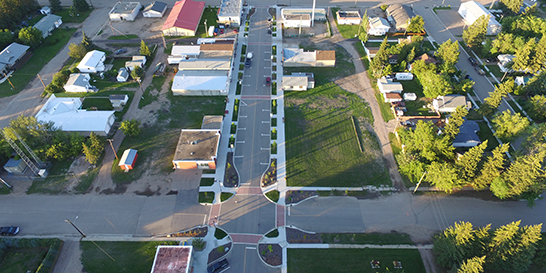|
This article is part of a series called Six sustainability ideas that have gone mainstream in Canada. Each article explores an innovative sustainability idea that may have seemed radical a decade ago but is now considered a best practice. The series features inspiring ideas and projects being implemented in Canadian cities and towns of all sizes, plus resources to help you implement these solutions in your community. |

Marwayne, AB revitalized its Center Street and reduced village's carbon footprint while creating an appealing space for residents doing day-to-day business and attending public events.
Canadian municipalities are facing some critical challenges that have an enormous impact on energy consumption and resilience:
- our population and infrastructure are aging
- our climate is changing, resulting in more weather-related crises
- our housing is less affordable and adaptable than is desirable
Low-carbon design and better land-use planning that incorporate sustainability principles can help alleviate these pressures.
What is low-carbon design?
Sustainable and low-carbon neighbourhoods are relatively compact, mixed-use communities with good access to transit that incorporate a range of housing, workplaces, parks, amenities, shops and services. In addition to sustainability, they contribute economic and social benefits to the community.
The principles of low-carbon design have been around for years but widespread acceptance has been slow. What's needed is a new development model that is both financially viable and focused on creating lasting social, economic and environmental value.
The key is to promote a shift in thinking that brings local governments, developers and community members to the same table to work toward their mutual benefit.
Design low-carbon neighbourhoods to reduce greenhouse gas emissions by more than 50 per cent
The benefits of this approach to land-use planning are significant. Dense, mixed-use communities can reduce:
- energy use and greenhouse gas emissions by more than 50 per cent
- infrastructure lifecycle costs by more than 25 per cent
- the risks from flooding and other related climate change impacts
Some municipalities — such as Vancouver, BC, and Oxford County, ON — are even working on becoming 100% Renewable Cities.
Ready to make your next neighbourhood a sustainable one?
See the case studies and videos of these FCM Sustainable Communities Award winners for sustainable neighbourhood design:
- Bois-Franc Transit-Oriented Development Plan, City of Montreal, QC
- Center Street Revitalization: From the Bottom Up!, Village of Marwayne, AB
Plus, read our free guidebook: Sustainable Neighbourhood Development: Practical Solutions to Common Challenges.
Discover more sustainability ideas and project examples
Read the other articles in this series for more sustainability ideas and project examples that you can use in your community:
- Cranbrook gains $1.2M in value by using wastewater for irrigation
- How Saint-Hyacinthe turns organic waste into biogas and revenue
- Innovative projects prepare older Brampton suburbs for climate change
- Why net-zero energy buildings reduce emissions and costs for communities
- Ways Ottawa increases cycling with green transit options
This series was inspired by "From Crazy to Common Sense: 'Radical' Ideas Whose Time Have Come," a workshop that was held at the Federation of Canadian Municipalities' 2016 Sustainable Communities Conference.
Move ideas to reality: Get funding and free resources from FCM's Green Municipal Fund
Subscribe to email updates and get the resources, training, networking opportunities and funding you need from FCM's Green Municipal Fund to implement these sustainability ideas in your community.
Want to explore all GMF-funded projects? Check out the Projects Database for a complete overview of funded projects and get inspired by municipalities of all sizes, across Canada.

